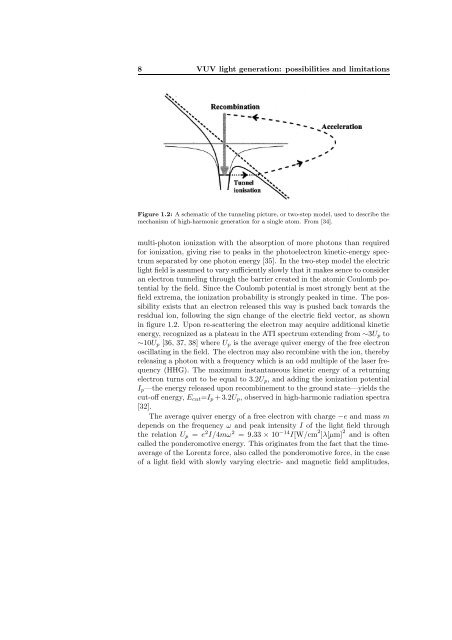VUV Spectroscopy of Atoms, Molecules and Surfaces
VUV Spectroscopy of Atoms, Molecules and Surfaces
VUV Spectroscopy of Atoms, Molecules and Surfaces
You also want an ePaper? Increase the reach of your titles
YUMPU automatically turns print PDFs into web optimized ePapers that Google loves.
8 <strong>VUV</strong> light generation: possibilities <strong>and</strong> limitations<br />
Figure 1.2: A schematic <strong>of</strong> the tunneling picture, or two-step model, used to describe the<br />
mechanism <strong>of</strong> high-harmonic generation for a single atom. From [34].<br />
multi-photon ionization with the absorption <strong>of</strong> more photons than required<br />
for ionization, giving rise to peaks in the photoelectron kinetic-energy spectrum<br />
separated by one photon energy [35]. In the two-step model the electric<br />
light field is assumed to vary sufficiently slowly that it makes sence to consider<br />
an electron tunneling through the barrier created in the atomic Coulomb potential<br />
by the field. Since the Coulomb potential is most strongly bent at the<br />
field extrema, the ionization probability is strongly peaked in time. The possibility<br />
exists that an electron released this way is pushed back towards the<br />
residual ion, following the sign change <strong>of</strong> the electric field vector, as shown<br />
in figure 1.2. Upon re-scattering the electron may acquire additional kinetic<br />
energy, recognized as a plateau in the ATI spectrum extending from ∼3Up to<br />
∼10Up [36, 37, 38] where Up is the average quiver energy <strong>of</strong> the free electron<br />
oscillating in the field. The electron may also recombine with the ion, thereby<br />
releasing a photon with a frequency which is an odd multiple <strong>of</strong> the laser frequency<br />
(HHG). The maximum instantaneous kinetic energy <strong>of</strong> a returning<br />
electron turns out to be equal to 3.2Up, <strong>and</strong> adding the ionization potential<br />
Ip—the energy released upon recombinement to the ground state—yields the<br />
cut-<strong>of</strong>f energy, Ecut=Ip +3.2Up, observed in high-harmonic radiation spectra<br />
[32].<br />
The average quiver energy <strong>of</strong> a free electron with charge −e <strong>and</strong> mass m<br />
depends on the frequency ω <strong>and</strong> peak intensity I <strong>of</strong> the light field through<br />
the relation Up = e 2 I/4mω 2 =9.33 × 10 −14 I[W/cm 2 ]λ[µm] 2 <strong>and</strong> is <strong>of</strong>ten<br />
called the ponderomotive energy. This originates from the fact that the timeaverage<br />
<strong>of</strong> the Lorentz force, also called the ponderomotive force, in the case<br />
<strong>of</strong> a light field with slowly varying electric- <strong>and</strong> magnetic field amplitudes,















